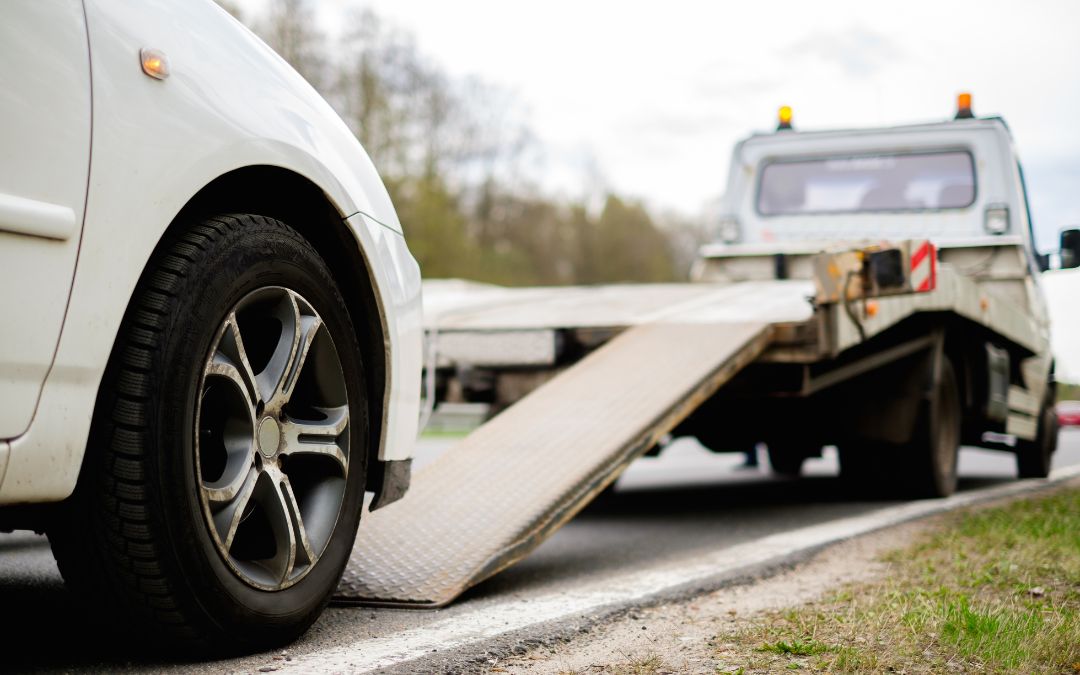When your car decides to act up and leaves you stranded, or you’re involved in an accident, the first moments can be daunting. Knowing what to do can make all the difference. As a stranded driver, your immediate actions can significantly impact your safety and the safety of others on the road.
Whether you’re dealing with a flat tire, a dead battery, or a more serious mechanical issue, staying calm and following these essential stranded car safety tips can help you navigate the situation smoothly. In this post, we’ll guide you through the steps to ensure you remain safe while waiting for a tow truck.
If you find yourself in this situation, do not hesitate to reach out to your local, trusted towing pros at Hanifen Towing. Our team is capable of handling any situation. Contact us today.
Assessing our situation: What to do first
Assessing your situation is the crucial first step that sets the tone for the rest of your journey to safety. When you find yourself in a stranded car, the immediate environment can be overwhelming, but taking a few deliberate actions can significantly reduce your risk and help you stay calm.
First, check your mirrors and surroundings for any oncoming traffic. This is vital to ensure that you are not in immediate danger. If you are on a busy highway, the risk of a collision is high, so you need to be aware of your surroundings at all times. Once you have a clear view of the traffic, turn on your hazard lights. This simple action alerts other drivers to your stranded car and reduces the risk of a collision. Hazard lights are a universal signal that you are in distress and need assistance.
Take Important Items with You
Having a charged phone is essential in these situations. Keep a list of emergency contacts, including a trusted towing company, in your phone. If you don’t have a specific towing service in mind, your insurance provider or a local mechanic can often recommend a reliable option. Call for help as soon as you can, and provide them with your location and the nature of your problem.
In addition to your phone, it’s a good idea to prepare a safety kit that includes items like flares, a flashlight, and a first aid kit. Flares can be used to mark your location and warn other drivers, while a flashlight can help you see and be seen in low-light conditions. A first aid kit is crucial in case of any injuries or emergencies. These items can make a significant difference in ensuring your safety while you wait for assistance.
Safety first: Protecting yourself on the highway
Before you do anything else, ensuring your own safety and that of your passengers must be your top priority. The moment you realize your vehicle is experiencing issues, the first step is to stay calm. If you are still in motion, try to slowly pull over to the side of the road, away from the flow of traffic. Once you have come to a stop, the first thing you should do is put on your seatbelt. This might seem counterintuitive, but it’s a crucial step to protect yourself in case of a collision or sudden movement.
If it’s safe to do so, move to the passenger seat. This position can offer an added layer of protection, especially if you are on a busy highway. The driver’s side is more exposed to passing vehicles, and moving to the passenger side can reduce the risk of injury. While you are waiting for help, keep your seatbelt fastened and avoid standing outside your vehicle. Highway safety is paramount, and the risk of being struck by another vehicle is a real concern.
Help Other Drivers Keep You Safe
To alert other drivers to your situation, use your hazard lights immediately. This is one of the most effective ways to signal that your vehicle is in distress and that other drivers should proceed with caution. If you have a warning triangle, place it at a safe distance behind your vehicle. This visual warning can help prevent additional accidents and keep you and your passengers safe. It’s essential to use these tools correctly and to ensure they are visible to oncoming traffic.
Staying in your vehicle is often the safest option, especially on a busy highway. The risks associated with fast-moving traffic are significant, and stepping out of your vehicle can put you in harm’s way. If you need to make a call or check your phone, do so from the safety of your vehicle. By remaining inside, you minimize the risk of being hit by a passing car and can better manage the situation until help arrives.
Communicating your dilemma: Who to call and what to say
Once you’re safe, it’s time to reach out for help—knowing who to call and what to say can streamline the process and reduce stress. If you’re in immediate danger, such as if your vehicle has been involved in a collision or if you’re in a remote area with no other cars around, calling 911 is your best option. However, for non-emergency situations, it’s more appropriate to contact a trusted tow truck company.
Before making any calls, take a moment to gather the essential information you’ll need to share. Your exact location is crucial, so if you have a GPS-enabled phone, use it to determine your coordinates or the nearest mile marker. If you’re on a highway, note the direction you were traveling and the nearest exit. Additionally, be prepared to provide a detailed description of your vehicle, including the make, model, color, and any distinguishing features. This information will help the tow truck company locate your stranded car quickly.
Communication is Key
When you make the call, clearly explain the problem you’re experiencing. Whether it’s a flat tire, a dead battery, or a more serious mechanical issue, the more specific you can be, the better. This will allow the tow truck company to send the right equipment and personnel to assist you. For example, if your stranded car is stuck in a ditch, they may need to bring a winch or other specialized tools.
Keep your charged phone accessible for updates and emergency calls. If you have a portable charger, keep it handy in case your battery starts to drain. Regularly check your phone for updates from the tow truck company and be prepared to provide additional information if needed. Staying calm and organized will help you manage the situation more effectively and ensure that you get the assistance you need as quickly as possible.
Preparing for the tow: How to safely move your vehicle
With the help on the way, your focus shifts to preparing your vehicle for the tow, a step that requires a bit of finesse. Before the tow truck arrives, it’s crucial to ensure your vehicle is in the safest and most stable position possible. Start by shifting your stranded car into park and engaging the parking brake. This prevents the vehicle from rolling and ensures it remains stable during the towing process. Next, turn off the engine to avoid any accidental movements or electrical issues.
Once your vehicle is secured, turn on your hazard lights to alert other drivers of your stranded car’s position. This is especially important if you are on a busy highway, as it helps prevent accidents and keeps you and other motorists safe. If it’s safe to do so, try to steer your car to the shoulder. This minimizes traffic disruption and enhances your overall highway safety. However, if moving the car poses a risk, it’s better to wait in a secure position.
While You’re Waiting for the Tow Truck
Before the tow truck arrives, take a moment to check for and remove any loose items from your vehicle. Loose objects can obstruct the towing process and potentially cause damage. Secure any items that could shift during transit, such as loose floor mats or personal belongings. This not only protects your belongings but also ensures the tow truck operator can work more efficiently and safely.
When the tow truck arrives, follow the operator’s instructions carefully. They are trained professionals and will guide you through the process to ensure a smooth and safe towing experience. If you have any questions or concerns, don’t hesitate to ask. Clear communication is key to a successful and stress-free towing process. Remember, the goal is to get your stranded car to a safe location with minimal hassle and maximum tow truck safety.
Choosing a reliable towing company: Tips and recommendations
Choosing a reliable towing company is the final piece of the puzzle, and a bit of research can save you a lot of headaches down the road. When your vehicle breaks down, the last thing you want is to add to your stress by dealing with an unreliable or unsafe towing service. One of the best ways to ensure you’re making the right choice is by checking local reviews and ratings. Platforms like Google Reviews, Yelp, and Angie’s List can provide valuable insights from other stranded drivers who have used these services. Look for consistent positive feedback on response times, professionalism, and the overall handling of the situation.
Key Factors to Consider
Once you’ve narrowed down your options, it’s essential to ask about insurance and safety protocols. A reputable towing company should have comprehensive insurance coverage to protect both their drivers and your vehicle. Inquire about their safety training and the measures they take to ensure secure towing. This is particularly important if you have a specialized or high-value vehicle. You want to make sure that the company has the expertise and equipment to handle your specific needs.
Another crucial factor to consider is the availability of 24/7 roadside assistance. Emergencies can happen at any time, and having a towing company that offers round-the-clock support can provide peace of mind. Verify that the company can assist you during all hours, including weekends and holidays. This ensures that you won’t be left stranded if your vehicle breaks down at an inconvenient time.
Response time is another key aspect to look for. A reliable towing company should guarantee quick response times, especially if you’re on a busy highway where safety is a top priority. Inquire about their average response times and what steps they take to ensure they can reach you swiftly. This can make a significant difference in reducing the time you spend in a potentially dangerous situation.
Experience Matters
Lastly, confirm the company’s experience with your vehicle type. Different vehicles have different towing requirements, and a company with specialized knowledge can provide the care your vehicle needs. Whether you drive a compact car, an SUV, or a heavy duty vehicle, make sure the towing service has the experience and equipment to handle it properly. This attention to detail can prevent further damage and ensure that your vehicle is transported safely and efficiently.
By taking the time to research and choose a reliable towing company, you can ensure a smoother and safer experience when you find yourself in a stranded car situation. With the right preparation and a trusted service provider, you can navigate these challenges with confidence and get back on the road as quickly and safely as possible.

